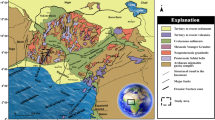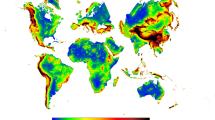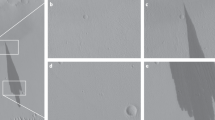Abstract
A COMPARISON of Earth-based photography with topographic data from Mariner 9 reveals that the winter polar hoods on Mars tend to extend further towards the equator at lower topographic heights than at higher topographic heights. The correlation between latitude of the hood boundary and topographic heights is shown in Figs 1 and 2. In Fig. 1, contour lines derived from a map by Christensen1 have been superimposed on the Lowell Observatory map of Martian Albedo Features and Topography2. To the author's knowledge, the Christensen map is the only published map that includes contour lines up to 65°N. The dashed lines represent the mean boundary of the polar hoods during twelve apparitions between 1905 and 1958, as determined from a study of Lowell Observatory's historical photographic collection. The southern hood boundary is in close agreement with a map by Capen3 that was made from measurements of more recent apparitions (1962–68), while the northern boundary agrees well with Mariner imaging4. In Fig. 2, the latitude of the hood boundaries (at 10° intervals in longitude) is plotted as a function of topographic height. The dashed line was fitted to the southern latitude points by least squares. The north hood points were then shifted along the ordinate until their average value fell on the dashed line. An equally good, if not better, correlation is found if one plots the latitude of the boundary of the southern hood against atmospheric pressure from the work of Conrath et al.5. The hood is found to extend farther north over areas of higher pressure than over areas of lower pressure. Comparable atmospheric pressure data are not available for the Northern Hemisphere.
This is a preview of subscription content, access via your institution
Access options
Subscribe to this journal
Receive 51 print issues and online access
$199.00 per year
only $3.90 per issue
Buy this article
- Purchase on Springer Link
- Instant access to full article PDF
Prices may be subject to local taxes which are calculated during checkout
Similar content being viewed by others
References
Christensen, E. J., J. geophys. Res., 80, 2911 (1975).
Inge, J. L., Mercury, 2, No 6, 10/11 (centrefold) (1973).
Capen, C. F., in Mars Scientific Model, Sec. 4.2, 26 (JPL Document 606-1, Pasadena, Calif., 1972).
Briggs, G. A., and Leovy, C. B., Bull. Am. met. Soc, 55, 278–296 (1974).
Conrath, B., et al., J. geophys. Res., 78, 4267 (1973).
Farmer, C. B., Icarus, 28, 279–289 (1976).
Author information
Authors and Affiliations
Rights and permissions
About this article
Cite this article
MARTIN, L. Correlation of Martian surface heights with latitude of polar hood boundaries. Nature 263, 668–669 (1976). https://doi.org/10.1038/263668a0
Received:
Accepted:
Published:
Issue Date:
DOI: https://doi.org/10.1038/263668a0
Comments
By submitting a comment you agree to abide by our Terms and Community Guidelines. If you find something abusive or that does not comply with our terms or guidelines please flag it as inappropriate.



